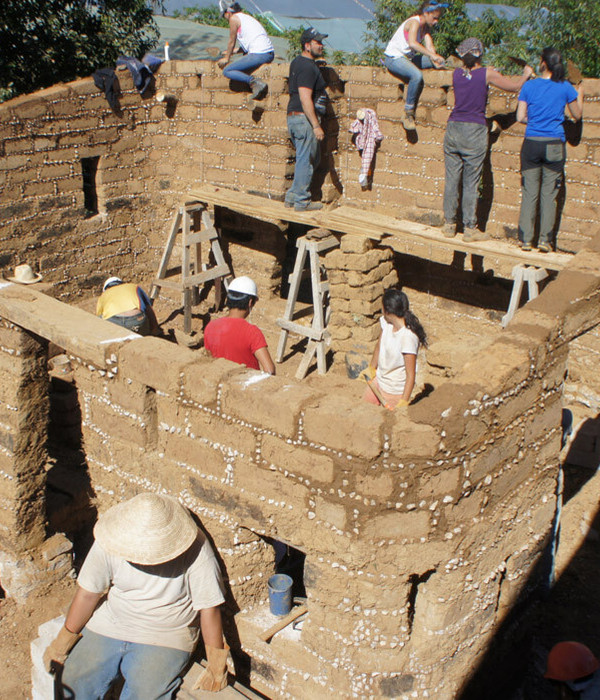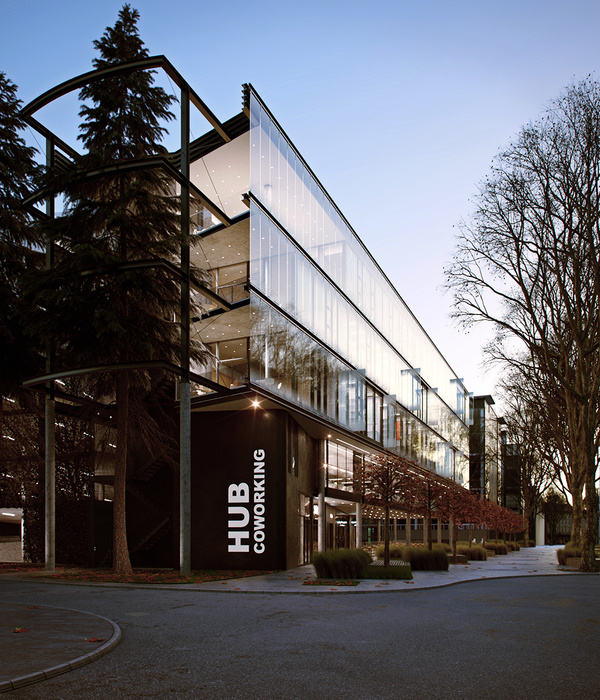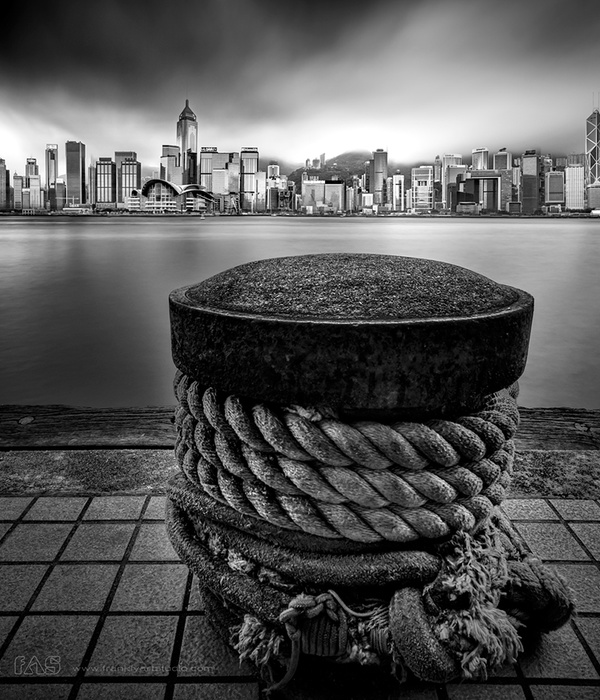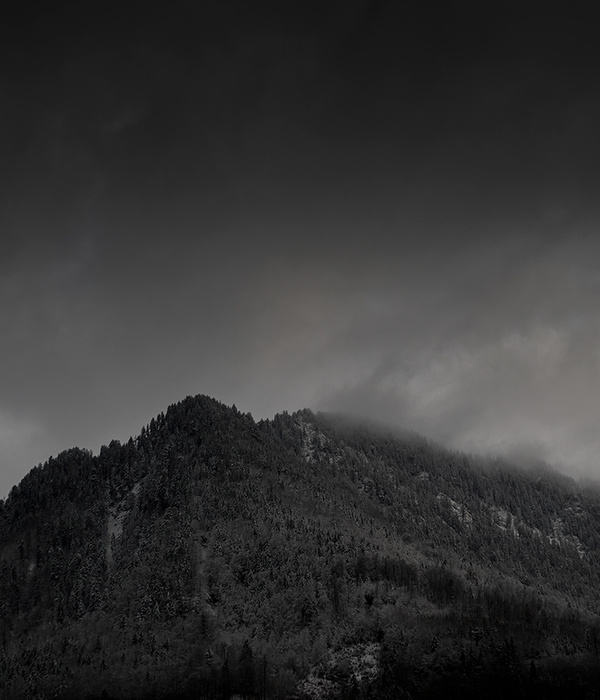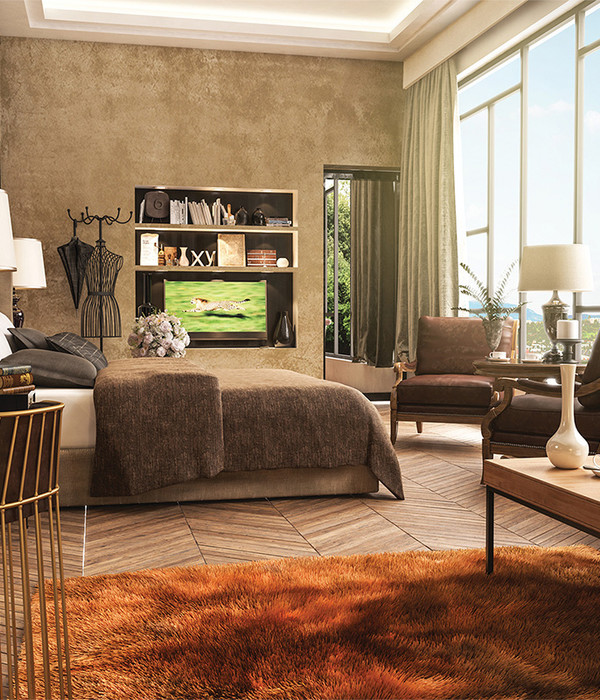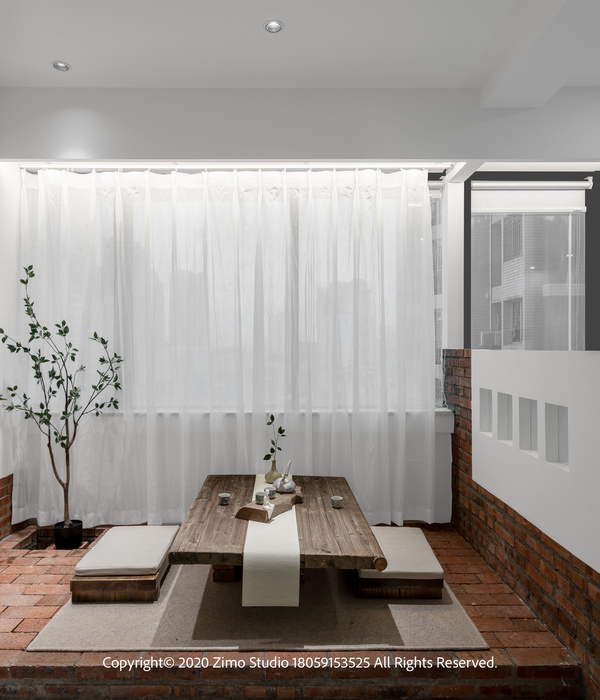© Anders Sune Berg
C.Anders Sune Berg
维耶尔湾位于日德兰,从它在维耶尔市的头向东延伸到卡特加特海的河口。Fjordenhus站在海港岛(Havne En)旁边的水中,这是一座人造岛屿,是根据维耶尔市政府(Vejle市)为振兴海港地区而开发的,在传统的工业环境中引入了重要的新住宅组件。对于那些从维耶尔的主要城市轴线接近的人来说,这座建筑似乎是焦点,周围是水,背景是维耶尔峡湾大桥(VejleFjord Bridge)。大楼前宽阔广场的混凝土和鹅卵石表面在Günther Vogt的码头设计中得到了回响,而Fjordenhus的圆柱形和独特的砖结构则与仓库和筒仓的历史海港类型相呼应。在峡湾的背景下,建筑物本身打破了平静的水面。
Vejle Fjord in Jutland stretches east from its head at the city of Vejle to its mouth at the Kattegat Sea. Fjordenhus stands in the water alongside Havneøen (The Harbour Island), a man-made island that was developed in response to a concept by Vejle Municipality to revitalise the harbour area, introducing important new residential components into a traditionally industrial environment. For those approaching from Vejle’s main urban axis, the building appears as the focal point, surrounded by water and with the Vejle Fjord Bridge in the background. The concrete and cobble-stone surfaces of the expansive plaza in front of the building are echoed in the design of Günther Vogt’s jetty, while the cylindrical forms and distinctive brickwork of Fjordenhus nod to the historical harbour typologies of warehouses and silos. Set against the backdrop of the fjord, the building itself breaks the smooth plane of the water.
© Anders Sune Berg
C.Anders Sune Berg
这座二十八米高的建筑是由四个相交的圆柱体形成的,这些圆柱体与砖的正面相交,从这些圆柱体上去除椭球形的负空间,以形成复杂的弯曲形式和拱形窗口。不同层次的楼层平面图是围绕圆形和椭圆形组织的,有专门设计的家具和灯光,并通过螺旋楼梯和圆形遗迹连接。对公众开放的双高度地地板由Fjord渗透,并包含两个含水区域,由OlafurEliasson拥有特定于场地的艺术品。KirkKapital办公室占据了上三层。位于建筑物顶部的是一个带有植被和太阳能电池板的绿色屋顶。在夜间,Fjorenhus从内部照亮,类似灯塔。
Accessible by footbridge, the twenty-eight-metre-high building is formed by four intersecting cylinders with brick facades from which ellipsoidal negative spaces were removed to create complex curved forms and arched windows. The varying floor plans of the different levels are organized around circles and ellipses, with specially designed furniture and lights, and are connected by spiral staircases and round vestibules. The double-height ground floor, which is open to the public, is permeated by the fjord and contains two aqueous zones with site-specific artworks by Olafur Eliasson. The KIRK KAPITAL offices occupy the upper three floors. Perched atop the building is a green roof with vegetation and solar panels. By night, Fjordenhus is lit from within, resembling a lighthouse.
© David de Larrea Remiro
(戴维·德·拉雷亚·雷米罗
经典的丹麦砖是建筑内部和外墙的主要材料。砖形成最小可能的建筑单元并遵循建筑物的有机形状。Fjorden-HUS复杂的砖砌游客“人们对建筑的印象就像他们所说的那样。从远处看,建筑的表面看起来是有秩序的,但是在更仔细的检查时,砖的不同形状和略微不规则的交错”深度揭示了一个生动、有机的表面。砖砌合了15种不同色调的未釉面砖;砖的其他颜色被集成到雕出的部分中,以产生颜色渐变--从底部的绿色和从顶部的蓝色-这反映了水和天空。在楼梯井,散射的银砖反射从上方照射的阳光。砖的作用不仅美观,而且在技术上是:中空的透气砖被放置在整个墙壁上,以调节声音和温度。每一个角落、小生境和弧线都需要一个单独的砖砌解决方案;每个砖都特别适合于混凝土墙的复杂曲率,整个砌体与弯曲的钢框架和立面的玻璃构件齐平。
Classic Danish brick is the predominant material of the building’s inner and outer walls. The brick forms the smallest possible building unit and follows the organic shape of the building. Fjorden- hus’s intricate brickwork shapes visitors’ impression of the building as they approach. From afar, the building’s surface seems orderly, but upon closer inspection, the different shapes and slightly irregular staggering of the bricks’ depth reveals a lively, organic surface. The brickwork incorporates fifteen different tones of unglazed brick; additional colours of glazed bricks are integrated into the carved-out sections to produce colour fades – green from the bottom and blue from the top – that reflect the water and sky. In the stairwell, scattered silver bricks reflect the sunlight shining in from above. The bricks function not only aesthetically, but also technically: hollow ventilation bricks are placed throughout the walls to modulate both sound and temperature. Every corner, niche, and arc required an individual brick-laying solution; each brick was specially t into the complex curvature of the concrete walls, the overall brickwork lying flush with the curved steel frames and glass elements of the facade.
© Anders Sune Berg
C.Anders Sune Berg
Floors & Ceilings
Fjordenhus的地板和天花板是由白色混凝土板构成的,每层都有3.2米高的空间。它们掩盖了技术基础设施(如供暖和冷却系统)的分布情况。在天花板上切割负圆形体积的网格模式减少了天花板的整体重量。这些空隙还可以容纳光的固定装置和调节空间的声学。Pietra Piasentina石被用来覆盖所有楼层。与经典的花岗岩石不同,Pietra Piasentina只能在意大利弗留利山开采的巨石中找到。
The floors and ceilings of Fjordenhus are formed by white concrete slabs, creating spaces 3.2 metres in height on each level. They conceal the distribution of technical infrastructure such as the heating and cooling systems. The grid pattern of cut-out negative circular volumes in the ceiling reduces the overall weight of the ceiling. These hollows also serve to hold light fixtures and modulate the acoustics of the space. Pietra Piasentina stone was used to cover all the floors. Unlike classic granite stones, Pietra Piasentina can only be found in boulders quarried from the hills of Friuli, Italy.
© Anders Sune Berg
C.Anders Sune Berg
Windows & Doors
双曲,三维形成的窗口精确地遵循菲尔德豪斯的几何图形。钢框架跨越了建筑的几层,而窗的空隙构成了正面的主要元素。在一些地区,引入旋转门以适应建筑物整体形状的几何挑战。所有的门窗都是倾斜的,根据设计,墙壁没有直角。
The double-curved, 3D-formed windows precisely follow the geometry of Fjordenhus. Steel frames span several floors of the building, while the window voids form the main element of the facade. In some areas, rotating doors were introduced to accommodate the geometrical challenges of the building’s overall shape. All of the doors and windows are tilted; by design, the walls contain no right angles.
© Anders Sune Berg
C.Anders Sune Berg
这些Kilim地毯直径9.4米,放置在鼓的中心,是在印度Varanasi手工编织的。织布机是定制的,这样地毯就可以无缝地编织,每条地毯都有不同的单色颜色。连接楼梯井和主要办公空间的较小的椭圆入口处安装了手簇绒地毯。所有的地毯都被精心设计成吸声剂。
The kilim carpets, each with a diameter of 9.4 metres and placed in the centres of the drums, were handwoven in Varanasi, India. Looms were custom-built so the carpets could be woven seamlessly, and each carpet comes in a different monochrome colour. The smaller, elliptical entrance rooms linking the stairwells to the main office spaces are fitted with hand-tufted carpets. All the carpets have been deliberately designed to be sound absorbant.
© Anders Sune Berg
C.Anders Sune Berg
大楼第一层、第二层和第三层的办公空间有几个定制家具,由Olafur Eliasson和Olafur Eliasson工作室设计。木材被引入作为主要材料,在私人空间的额外内置橱柜,浴室,厨房和楼梯。
The office spaces on the building’s first, second, and third floors feature several custom-made furniture pieces designed by Olafur Eliasson and Studio Olafur Eliasson. Wood was introduced as the dominant material for the additional built-in cabinets, bathrooms, kitchens, and staircases in the private spaces.
© Anders Sune Berg
C.Anders Sune Berg
Architects Sebastian Behmann, Studio Olafur Eliasson
Location Havneøen 1, 7100 Vejle, Denmark
Artist Olafur Eliasson
Architectural Team Sebastian Behmann with Studio Olafur Eliasson
Project Year 2018
Photographs Anders Sune Berg, David de Larrea Remiro
Category Office Buildings
{{item.text_origin}}


